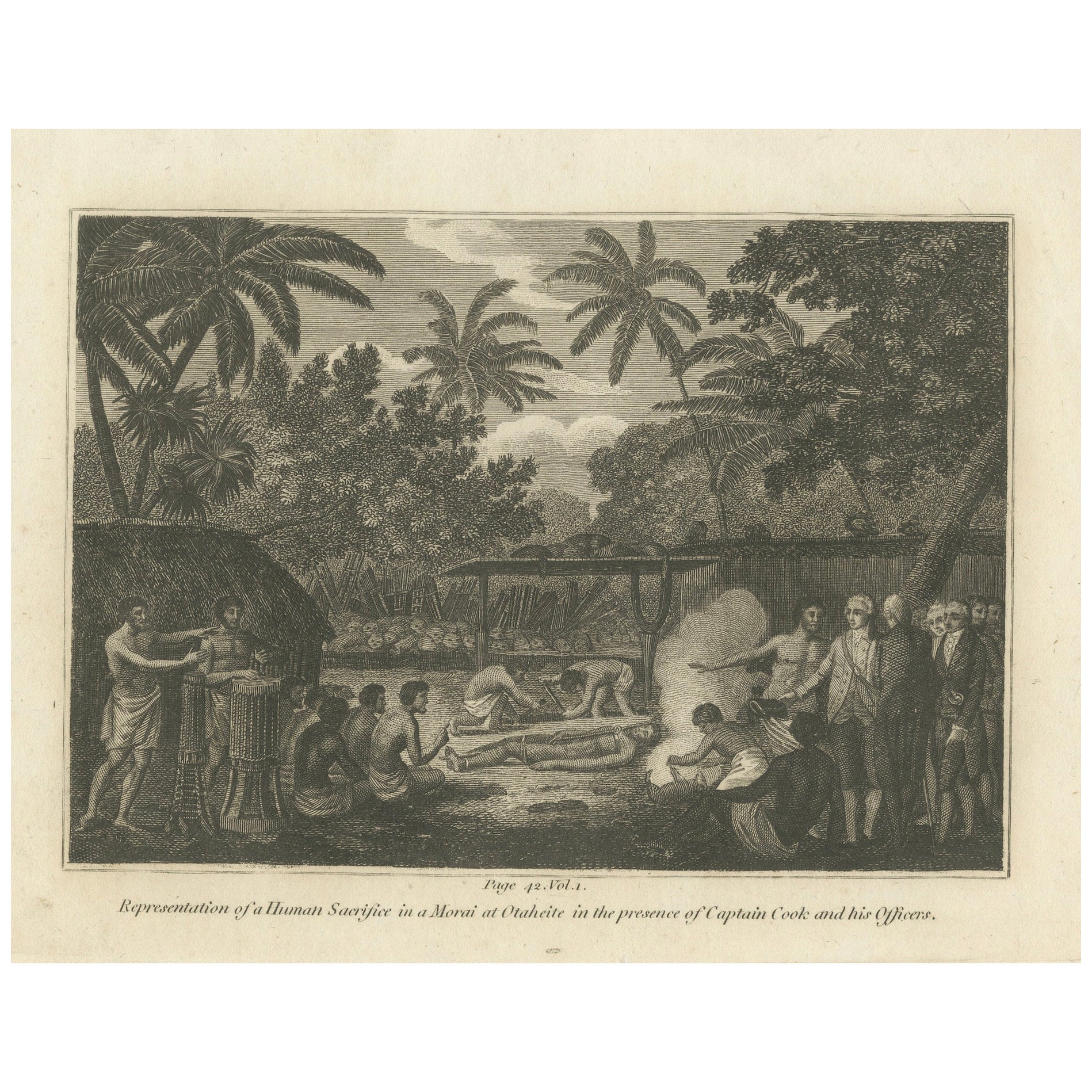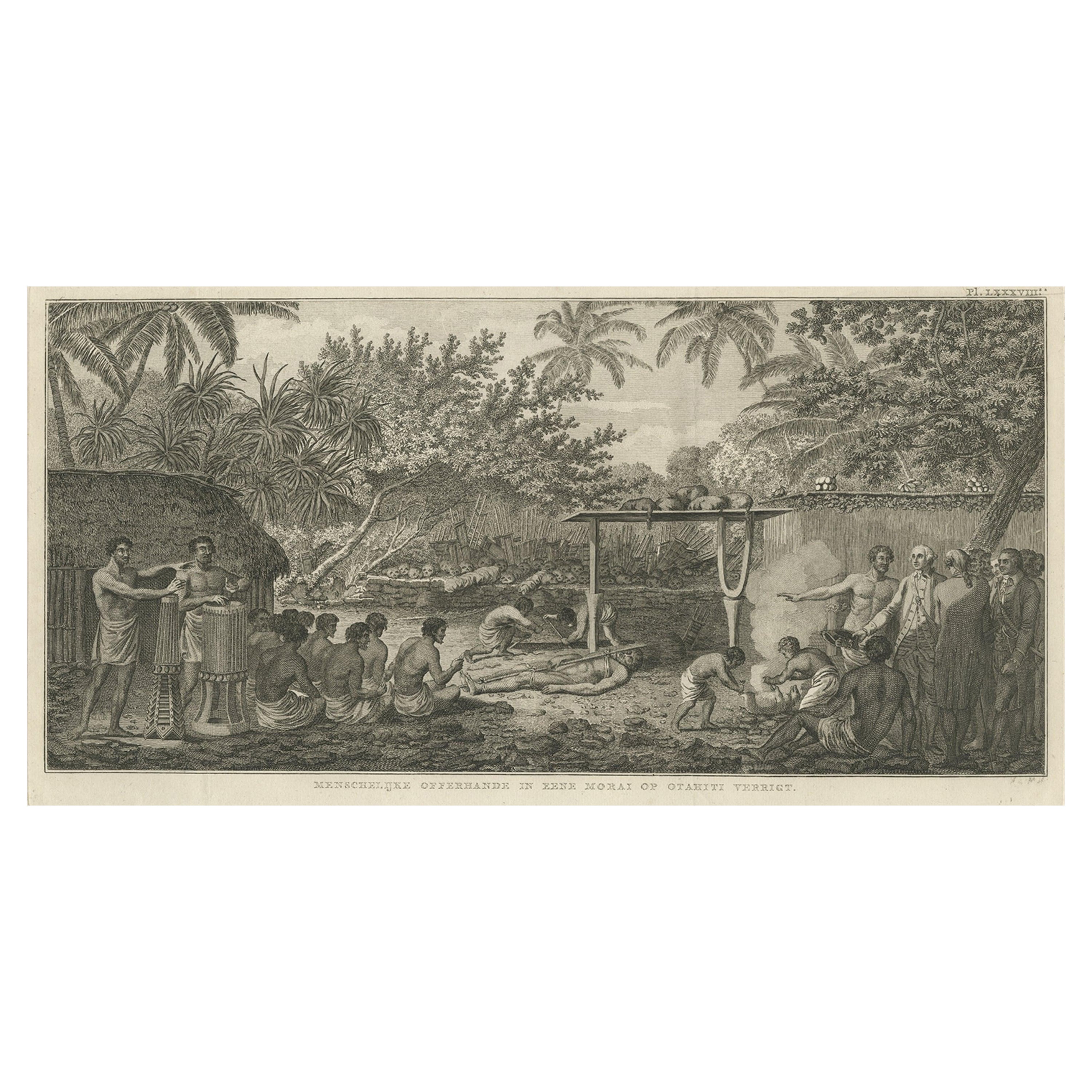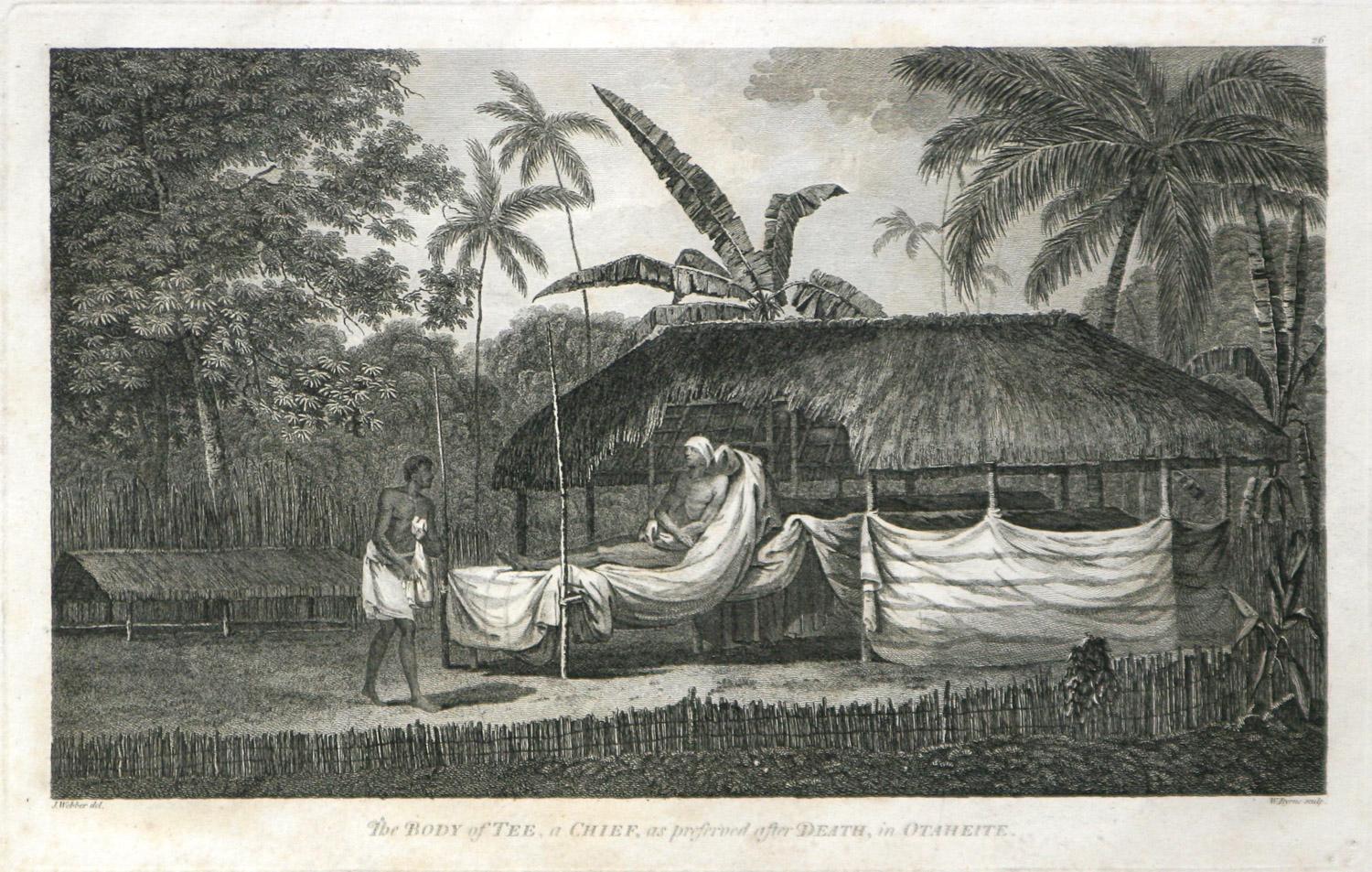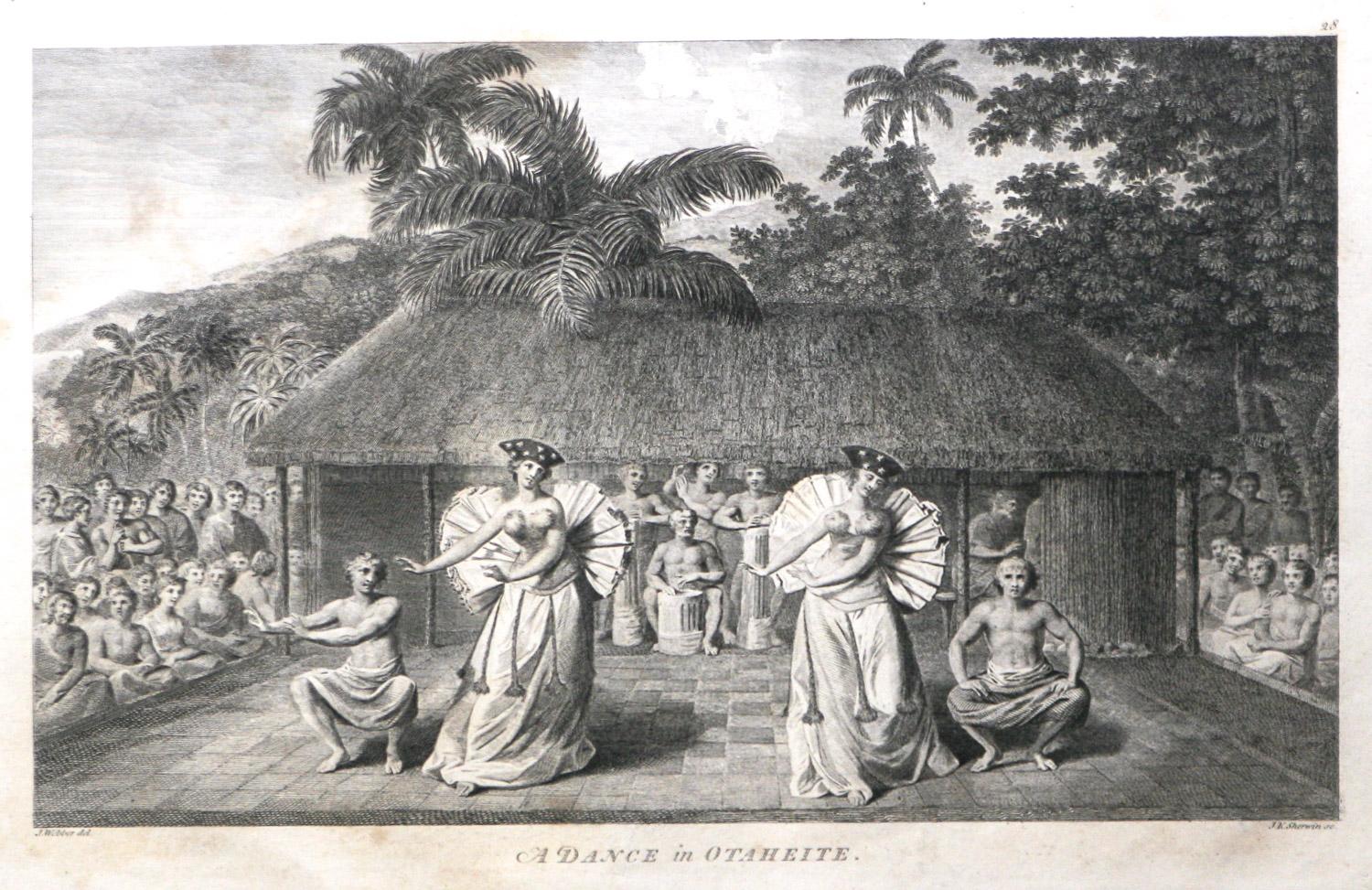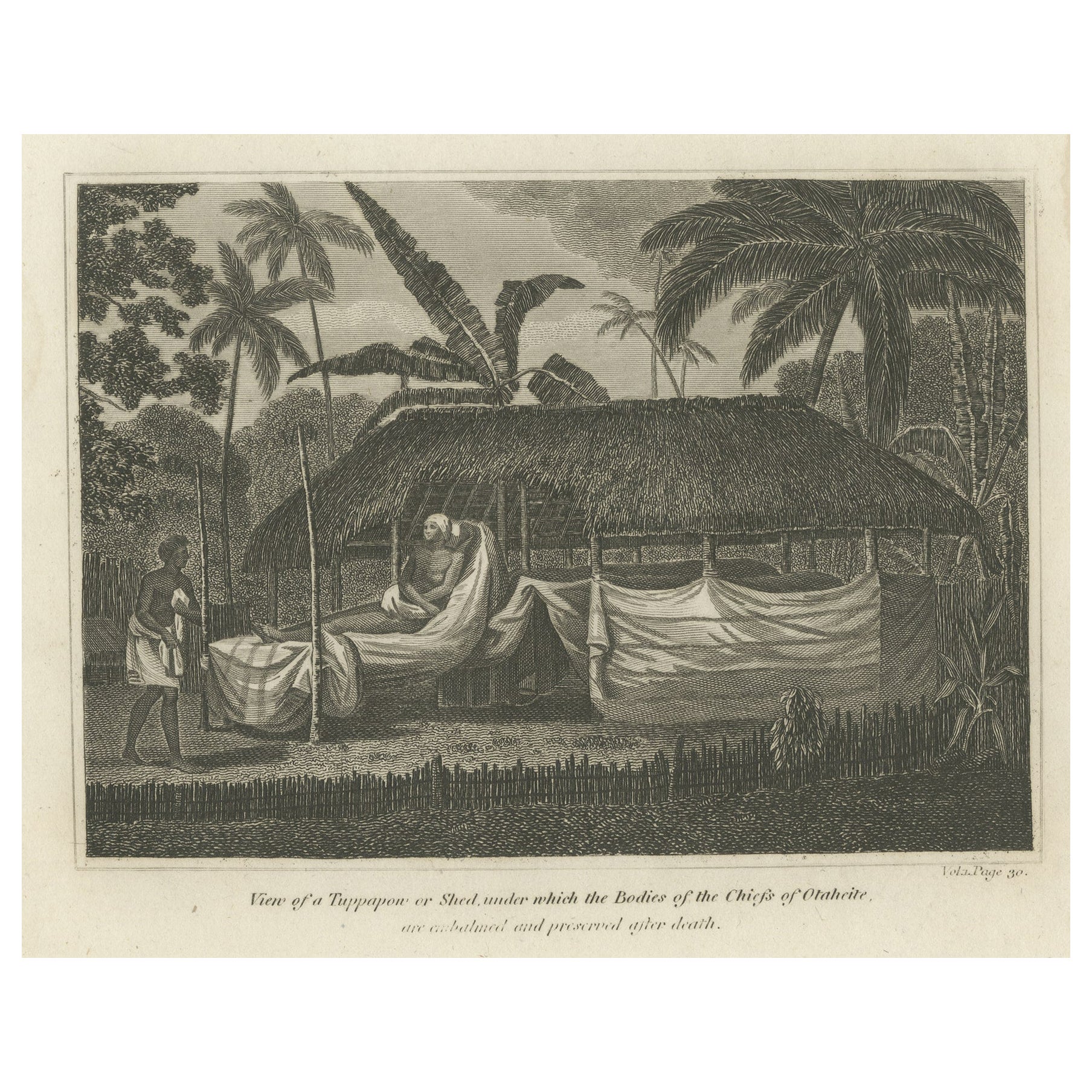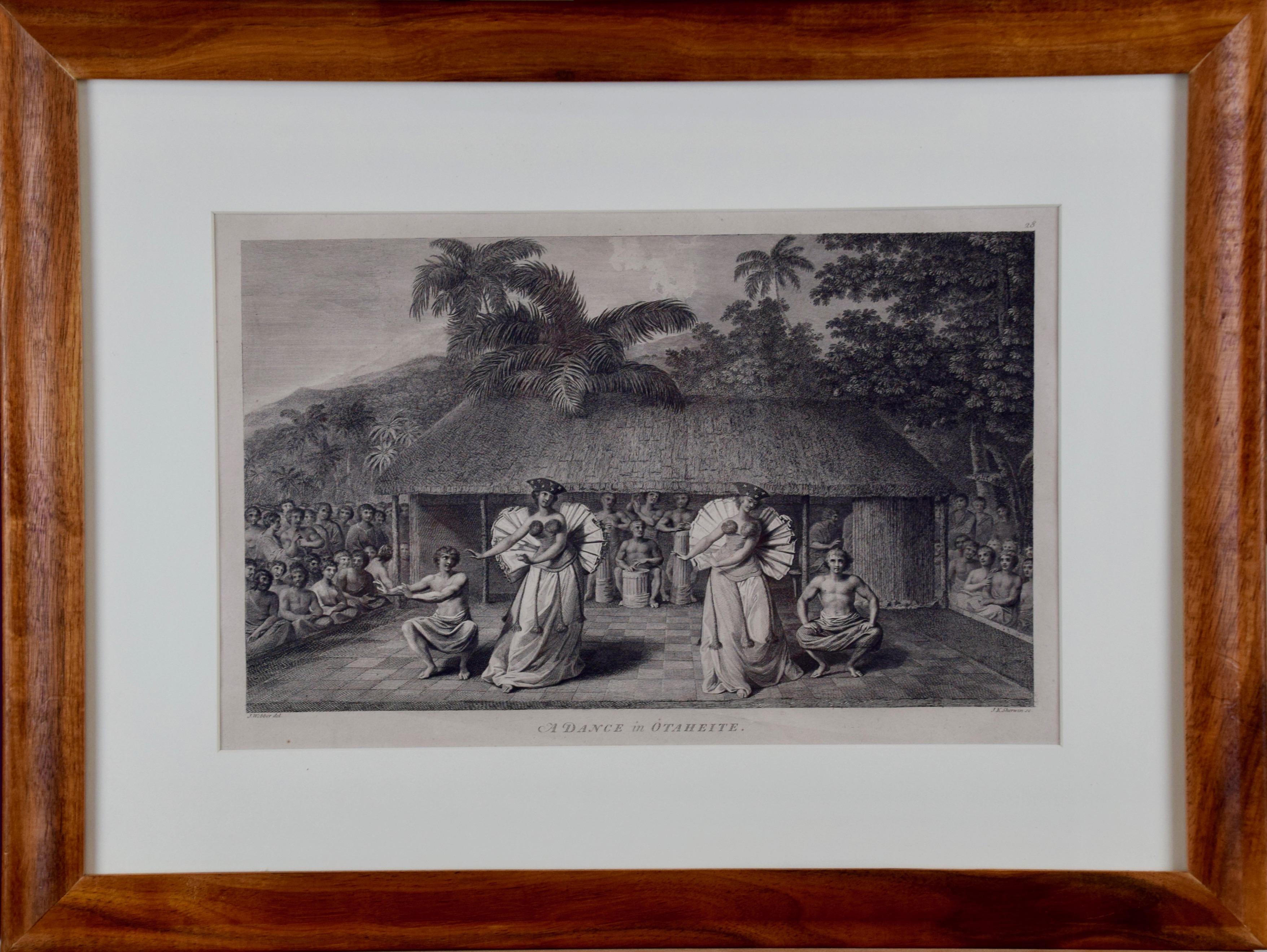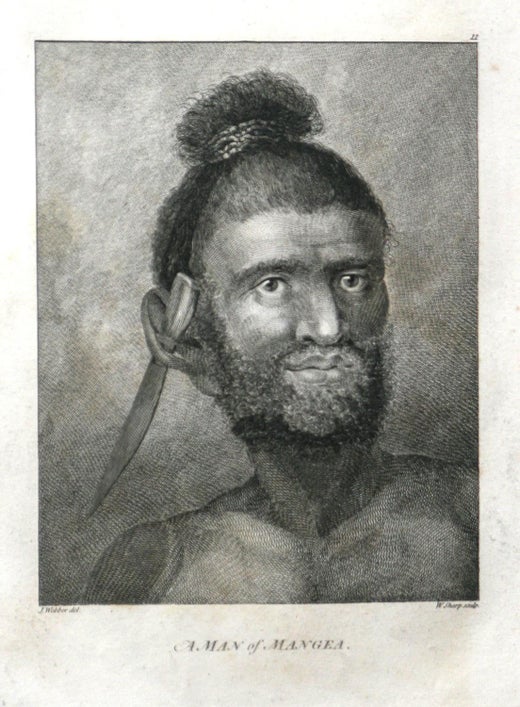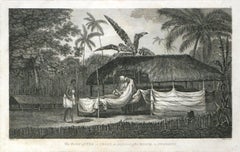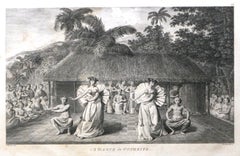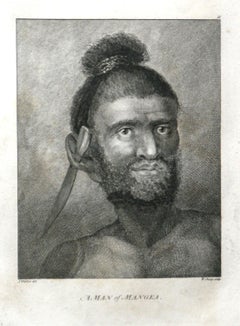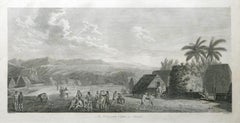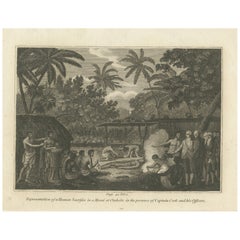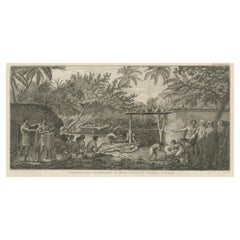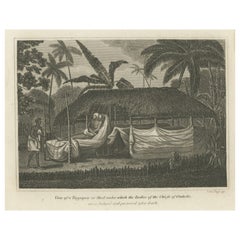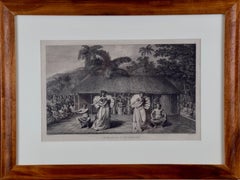Items Similar to A Human Sacrifice, in a Morai, in Otaheite (Tahiti) 1784 James Cook Final Voyage
Want more images or videos?
Request additional images or videos from the seller
1 of 8
John WebberA Human Sacrifice, in a Morai, in Otaheite (Tahiti) 1784 James Cook Final Voyage1784
1784
$1,950
£1,484.11
€1,699.71
CA$2,773.56
A$3,039.43
CHF 1,587.25
MX$36,525.60
NOK 19,843.41
SEK 18,715.50
DKK 12,686.44
About the Item
A Human Sacrifice in a Morai in Otaheite (Tahiti) 1784 by John Webber is from the First Edition Atlas Accompanying Capt. James Cook and King; Third and Final Voyage of Captain James Cook. John Webber (1752-1793) was the official artist for the third voyage of Captain James Cook (1728-1779). The purpose of this voyage was to discover the Northwest Passage and to explore the Pacific Ocean north of the Equator.
Cook arrived at Matavia Bay, Tahiti on 24th August,1777 and stayed until the 30th of September, 1777. While there Cook witnessed a human sacrifice at the great Morai at Attahouroo ( Utuaimahurau ), Tahiti. In the center foreground we see a bound figure. Behind him we can see men digging a hole and the Whatta which contained the sacrificed bodies of three pigs and two dogs. On the left are two drummers, the chief priest and several other priests around him. Standing on the right we can see Otoo (Tu), Captain Cook and several of his officers including William Anderson and Omai. This drawing became one of the most deeply remembered and an image that never failed to arouse missionary fervor. The visual presence of Cook as the friend of Tu seemed to show Cook as complicit in the rite. Both Cook and Anderson had been deeply shocked by the ceremony. "During the ceremony we were silent but as soon as it was over we made no scruple in giving our sentiments very freely upon it and of course condemned it. "
These engravings were published in 1784-85 by G. Nichol and Thomas Cadell of London in the four large format atlas, Voyage to the Pacific Ocean. Captain Cook was an extraordinary explorer known for discovering and mapping unknown territory and for his many contributions to the scientific world. These original engravings from Webber's drawings and paintings are only a glimpse into this great man's historical contributions that make him one of the greatest explorers of all times. This engraving is in good condition. There is some foxing and a few small tears in the margins.
- Creator:John Webber (1751 - 1793, British)
- Creation Year:1784
- Dimensions:Height: 16.5 in (41.91 cm)Width: 22 in (55.88 cm)
- More Editions & Sizes:nonePrice: $1,950
- Medium:
- Movement & Style:
- Period:1780-1789
- Condition:
- Gallery Location:Paonia, CO
- Reference Number:1stDibs: LU780313678872
John Webber
John Webber (1751-1793) was recommended to the Admiralty for appointment as artist for the Captain Cook's 3rd voyage by the Swedish botanist Daniel Carlsson Solander (1733-1782) who had accompanied Cook on his first voyage. Just 24 years old when he joined the Captain Cook’s ship the Resolution at Plymouth one week prior to departure, Webber's skill in both portraiture and landscape resulted in a visual record of Cook's third voyage that is unsurpassed in the annals of 18th century exploration.
About the Seller
4.9
Gold Seller
Premium sellers maintaining a 4.3+ rating and 24-hour response times
Established in 1978
1stDibs seller since 2017
128 sales on 1stDibs
Typical response time: 2 hours
- ShippingRetrieving quote...Shipping from: Paonia, CO
- Return Policy
Authenticity Guarantee
In the unlikely event there’s an issue with an item’s authenticity, contact us within 1 year for a full refund. DetailsMoney-Back Guarantee
If your item is not as described, is damaged in transit, or does not arrive, contact us within 7 days for a full refund. Details24-Hour Cancellation
You have a 24-hour grace period in which to reconsider your purchase, with no questions asked.Vetted Professional Sellers
Our world-class sellers must adhere to strict standards for service and quality, maintaining the integrity of our listings.Price-Match Guarantee
If you find that a seller listed the same item for a lower price elsewhere, we’ll match it.Trusted Global Delivery
Our best-in-class carrier network provides specialized shipping options worldwide, including custom delivery.More From This Seller
View AllThe Body of Tee, a Chief, as preferred after Death, in Otaheite (Tahiti)
By John Webber
Located in Paonia, CO
The Body of Tee a chief as preferred after Death in Otaheite (Tahiti) is from the 1784 First Edition Atlas Accompanying Capt. James Cook and King; Third and Final Voyage of Capt...
Category
1870s Realist Figurative Prints
Materials
Engraving
A Dance in Otaheite (Tahiti) 1784 James Cook Final Voyage by John Webber
By John Webber
Located in Paonia, CO
A Dance in Otaheite ( Tahiti ) is from the 1784 First Edition Atlas Accompanying Capt. James Cook and King; Third and Final Voyage of Captain James Cook. John Webber (1752-1793) who...
Category
1780s Realist Figurative Prints
Materials
Engraving
A Man of Mangea 1784 final voyage of Captain Cook by John Webber
By John Webber
Located in Paonia, CO
A Man of Mangea is from the 1784 First Edition Atlas Accompanying Capt. James Cook and King; Third and Final Voyage of Captain James Cook. John Webber (1752-1793) was the official a...
Category
1780s Realist Portrait Prints
Materials
Engraving
An Inland View; in Atooi ( Hawaii ) 1784 Captain Cook engraving by John Webber
By John Webber
Located in Paonia, CO
An Inland View in Atooi ( Hawaii ) is from the 1784 First Edition Atlas Accompanying Capt. James Cook and King; Third and Final Voyage of Captain James Cook. This engraving depicts ...
Category
1780s Realist Landscape Prints
Materials
Engraving
A Man of the Sandwich Islands, Dancing (Hawaii) from Captain Cooks travels engra
By John Webber
Located in Paonia, CO
A Man of the Sandwich Islands Dancing (Hawaii) is from the 1784 First Edition Atlas Accompanying Capt. James Cook and King; Third and Final Voyage of Captain James Cook. John Webber (1752-1793) was the official artist for the third voyage of Captain James Cook (1728-1779). The purpose of this voyage was to discover the Northwest Passage and to explore the Pacific Ocean north of the Equator. These engravings were published in 1784-85 by G. Nichol and Thomas Cadell of London in the four large format atlas, Voyage to the Pacific Ocean. Captain Cook was an extraordinary explorer known for discovering and mapping unknown territory and for his many contributions to the scientific world. These original engravings from Webber’s drawings and paintings are only a glimpse into this great man’s historical contributions that make him one of the greatest explorers of all times.
This image shows a Hawaiian dancer...
Category
1780s Realist Figurative Prints
Materials
Engraving
A Young Woman of Otaheite, Dancing (Tahiti) 1784 Captain Cooks Voyage by Webber
By John Webber
Located in Paonia, CO
A Young Woman of Taheite Dancing (Tahiti) is from the 1784 First Edition Atlas Accompanying Capt. James Cook and King; Third and Final Voyage of Captain James Cook.John Webber (1752-...
Category
1780s Realist Figurative Prints
Materials
Engraving
You May Also Like
Ceremonial Rites: A Human Sacrifice in Otaheite (Tahiti), 1801
Located in Langweer, NL
The title for the provided engraving could be "Ceremonial Rites: A Human Sacrifice in Otaheite," capturing the gravity of the depicted event. This print likely illustrates a solemn a...
Category
Antique Early 1800s Prints
Materials
Paper
Human Sacrifice in a Morai, Tahiti – Cook Voyage Engraving c.1795
Located in Langweer, NL
Menschelijke Offerhande in eene Morai of Otahiti verrigt – Human Sacrifice in Tahiti c.1795
This antique print depicts a dramatic and solemn scene of a human sacrifice performed in ...
Category
Antique Early 1800s European Prints
Materials
Paper
$706 Sale Price
20% Off
Free Shipping
Mourning the Chief: Engraving of The Morai at Otaheite, now called Tahiti, 1817
Located in Langweer, NL
An original historical engraving from G. Alexander Cooke's "Geography," published in 1817. The engraving is titled "View of a Tuppapon or Shed under which the Bodies of the Chiefs of...
Category
Antique 1810s Prints
Materials
Paper
$467 Sale Price
20% Off
Free Shipping
"A Dance in Otaheite" (Tahiti), Engraving from Captain Cook's 3rd Voyage
By John Webber
Located in Alamo, CA
"A Dance in Otaheite" (Tahiti) is an engraving created by William Sharp (1749-1824), from a drawing by John Webber (1752-1793), who was the artist on Captain James Cook's 3rd and final voyage of discovery. It is a plate in the atlas of "A Voyage to the Pacific Ocean Undertaken by the Command of His Majesty, for Making Discoveries in the Northern Hemisphere", the official British Admirality sanctioned journal published upon completion of the voyage in London in 1784 by Strahan & Cadell.
Two women and two men wearing ceremonial costumes, performing a dance outdoors standing on a mat. Three men are playing the drums in the background, in front of a thatched roof building. An audience of men are sitting on both sides of the stage. By the time Webber arrived in Tahiti, 'south sea' imagery had become familiar. Webber gave concentrated attention to dance. He had the opportunity to distinguish the Tahitian dance from the more formalized dancing of Tonga. Whereas they seem to have called to mind the more formal dances of antiquity, the Tahitian dancing aroused memories of peasant and folk dancing.
This engraving is professionally framed in Koa wood. Koa wood is legendary in Hawaii. Not only is this amazing wood native to Hawaii, but it is known for the deep rich colors and varied grain pattern. Koa has an honored heritage in Hawaii and is highly revered and sacred. The word “koa” means “warrior” in Hawaiian. The warriors of King Kamehameha the Great, created canoes and weapons from a wood plentiful on the Big Island of Hawaii. This wood became synonymous with the warriors themselves, and it became known as koa.
The print is in excellent condition.
There are three other engravings listed from the official journal of Captain Cook's 3rd voyage available that are presented in identical Koa wood frames and double mats (LU117324682432, LU117324684052, LU117324684062). They would make a wonderful grouping for a display of 2, 3 or 4 prints. A discount is available for a grouping depending on the number of items included.
Hawaii was discovered by Captain Cook during this voyage. Hawaii was originally called The Sandwich Islands in honor of The Earl of Sandwich...
Category
1780s Realist Landscape Prints
Materials
Engraving
De Natsche – Ceremony for the King's Son, Tonga c.1795
Located in Langweer, NL
De Natsche – Ceremony for the King's Son, Tonga c.1795
This antique print depicts a grand ceremony held in honour of the son of the King of Tonga, known as the Natsche, in the villa...
Category
Antique Early 1800s European Prints
Materials
Paper
$563 Sale Price
20% Off
Surrender of Tahiti to Captain Wallis: An Original 18th C. Engraving
By John Webber
Located in Alamo, CA
"A Representation of the Surrender of the Island of Otaheite to Capt.n Wallis, by the Supposed Queen of Oberea" is an original 18th century engraving created by Sparrow, from a drawi...
Category
1780s Landscape Prints
Materials
Engraving
More Ways To Browse
Captain Cook
Andre Brasilier Lithograph
Andy Warhol Signed Dollar Bill
Area Nightclub
Boris Kochno
Chagall Bird
Chagall Oiseau
Chanel No 5 Print
Chikanobu Woodblock Print
Cleo De Merode
Da Vinci Etching
Dali Flordali
Dali Signature
Dali Tarot
Dali Time And Space
Daphnis Et Chloe
David Hockney Los Angeles
David Hockney Opera
